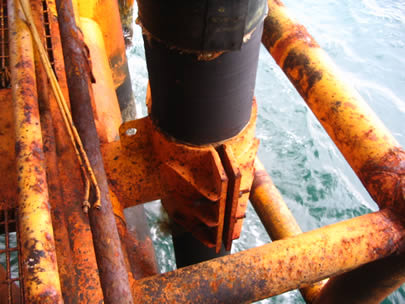swengi
Structural
- Aug 6, 2018
- 12
Hi
This is my first post on this Forum. I'm interested to see what responses there are to my query as I'm having difficulty getting an answer from Dr Google.
My problem is as follows:
We have been asked to certify a clamp. The clamp is a steel collar around a 2800mm DIA reinforced concrete pier, with a four (4) bolt configuration each side of the clamp. Each of the four bolts are proposed to be tensioned to 200 kN. The collar is designed to resist vertical sliding on the pier.
My question is this: What is the sliding resistance of the clamp, assuming the coefficient of friction is 0.3? Is it 200 x 0.3, or is it 4 x 200 x 0.3?
I would have said that the sliding resistance is 200 x 0.3, as there is only 200 kN of total tension in the system (despite there being four bolts). However, other engineers have claimed that we should allow 4 x 200 x 0.3 (i.e. the bolt clamping forces are additive).
It would be great to hear people's opinions on how to design such a connection and also if there are any useful references available for pipe clamp design. As I mentioned, I am really struggling to find any reference material. I'm happy to provide more information if any of the above is unclear.
Thanks!
This is my first post on this Forum. I'm interested to see what responses there are to my query as I'm having difficulty getting an answer from Dr Google.
My problem is as follows:
We have been asked to certify a clamp. The clamp is a steel collar around a 2800mm DIA reinforced concrete pier, with a four (4) bolt configuration each side of the clamp. Each of the four bolts are proposed to be tensioned to 200 kN. The collar is designed to resist vertical sliding on the pier.
My question is this: What is the sliding resistance of the clamp, assuming the coefficient of friction is 0.3? Is it 200 x 0.3, or is it 4 x 200 x 0.3?
I would have said that the sliding resistance is 200 x 0.3, as there is only 200 kN of total tension in the system (despite there being four bolts). However, other engineers have claimed that we should allow 4 x 200 x 0.3 (i.e. the bolt clamping forces are additive).
It would be great to hear people's opinions on how to design such a connection and also if there are any useful references available for pipe clamp design. As I mentioned, I am really struggling to find any reference material. I'm happy to provide more information if any of the above is unclear.
Thanks!


![[idea] [idea] [idea]](/data/assets/smilies/idea.gif)
![[r2d2] [r2d2] [r2d2]](/data/assets/smilies/r2d2.gif)